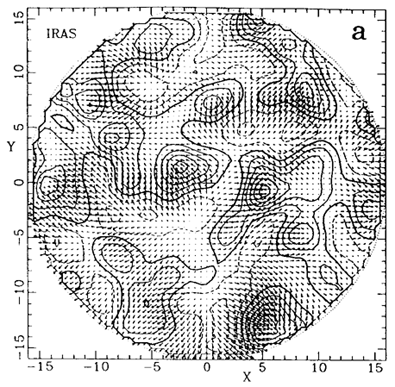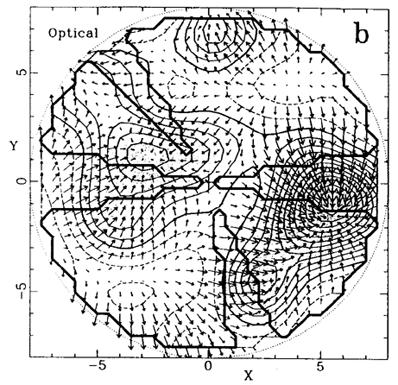Copyright © 1994 by Annual Reviews. All rights reserved
| Annu. Rev. Astron. Astrophys. 1994. 32:
371-418 Copyright © 1994 by Annual Reviews. All rights reserved |
All-sky complete redshift surveys provide extremely valuable data complementary to the peculiar velocity data, and the efficient techniques for measuring redshifts make them deeper, denser, and more uniform. Under the assumption of GI and an assumed biasing relation between galaxies and mass, a redshift survey enables an independent reconstruction of the density and velocity fields. The comparison of the smoothed fields recovered from redshifts and from velocities is a very important tool for testing the basic hypotheses and for determining the cosmological parameters.
The solution to the linearized GI equation  · v =
-f
· v =
-f  for an irrotational field is
for an irrotational field is
The velocity is proportional to the gravitational
acceleration, which ideally requires full knowledge of
the distribution of mass in space.
In practice (Yahil et al. 1991)
one is provided with a flux-limited, discrete redshift
survey, obeying some radial selection function
Under the assumption of linear biasing,
Equations (20-21) can be solved iteratively: make a first guess for the
xi, compute the vi by
Equation (20), correct the xi by Equation (21),
and so on until convergence. The convergence can be improved by
increasing
SELECTION FUNCTION. An accurate knowledge of the probability that
a galaxy at a given distance be included in the sample is essential,
especially at large distances where
ZONE OF AVOIDANCE. Regions in the sky not covered by the survey
have to be filled with mock galaxies by some method of extrapolation from
nearby regions. One way is to distribute these galaxies Poissonianly
with the mean density of an adjacent volume, or to actually clone the
adjacent region (Hudson 1993a).
A more sophisticated extrapolation uses
spherical harmonics and the Wiener filter method (e.g.
Lahav et al. 1994).
TRIPLE-VALUED ZONES. Galaxies in three different positions along
a line of sight
through a contracting region may have the same redshift. Given a
redshift in a collapsing region where the problem is not resolved by the
smoothing used, one can either take some average of the three solutions,
or make an intelligent choice between them, e.g. by using the velocity
field derived from observed velocities.
ESTIMATING SHOT-NOISE. This major source of error due to the
finite number of galaxies can be crudely estimated using bootstrap
simulations, where each galaxy is replaced with k galaxies,
k being a Poisson deviate of <k> = 1. For each realization
one calculates
NONLINEAR BIASING. Galaxies need not be faithful
tracers of the mass (e.g.
Dekel & Rees 1987), but there
is growing evidence that they are strongly
correlated (Section 6.2). This correlation
can be crudely
assumed to be a deterministic relation between the local smoothed
density fields, e.g. linear biasing
QUASILINEAR CORRECTION. Even after 12 h-1Mpc smoothing,
The IRAS Point Source Catalog served as the source for two very
valuable redshift surveys, which have been carried out and analyzed in
parallel. One contains the 5313 galaxies brighter than 1.2 Jy at
60µm with sky coverage (almost) complete for |b| > 5°
covering 88% of the sky
(Strauss et al. 1990,
1992a, to 1.9 Jy;
extended by Fisher 1992).
The other is a 1-in-6 sparsely-sampled survey of 
 all
space d3 x'
all
space d3 x'  (x') [(x' -
x) / |x' - x|3].
(x') [(x' -
x) / |x' - x|3].
 (r).
The galaxy density is estimated by
1 +
(r).
The galaxy density is estimated by
1 +  g(x) =
g(x) =  n-1
n-1  (ri)-1
(ri)-1  3dirac(x -
xi), where n
3dirac(x -
xi), where n  V-1
V-1
 (ri)-1 is the mean galaxy
density,
and the inverse weighting by
(ri)-1 is the mean galaxy
density,
and the inverse weighting by  restores the equal-volume weighting. Equation (19) is then replaced by
restores the equal-volume weighting. Equation (19) is then replaced by
 / 4
/ 4
 r <
Rmax d3 x'
r <
Rmax d3 x'  g(x')
S(|x' - x|) [(x' - x) / |x' -
x|3].
g(x')
S(|x' - x|) [(x' - x) / |x' -
x|3].
 g = b
g = b  , the cosmological dependence
enters through
, the cosmological dependence
enters through


 ) / b
) / b 500 km s-1)
essential for reducing the effects of non-linear gravity,
shot-noise, distance uncertainty, and triple-value zones.
The distances are estimated from the redshifts in the LG frame by
500 km s-1)
essential for reducing the effects of non-linear gravity,
shot-noise, distance uncertainty, and triple-value zones.
The distances are estimated from the redshifts in the LG frame by
 gradually during the iterations. Relevant issues follow.
gradually during the iterations. Relevant issues follow.
 -1 can introduce large
errors. For a given flux limit,
-1 can introduce large
errors. For a given flux limit,  can be evaluated together with the luminosity function using
a maximum-likelihood technique independent of density inhomogeneities.
can be evaluated together with the luminosity function using
a maximum-likelihood technique independent of density inhomogeneities.
 and n,
corrects for the ZOA, and solves for the linear velocity field. The
mean and variance of the resulting density field are measures of the
systematic and random errors. The bootstrap simulations demonstrate that
the uncertainty in
and n,
corrects for the ZOA, and solves for the linear velocity field. The
mean and variance of the resulting density field are measures of the
systematic and random errors. The bootstrap simulations demonstrate that
the uncertainty in  g from the 1.2 Jy IRAS sample is typically
less than 50% of the uncertainty in the density derived by POTENT from
observed Mark III velocities.
g from the 1.2 Jy IRAS sample is typically
less than 50% of the uncertainty in the density derived by POTENT from
observed Mark III velocities.
 g = b
g = b , which is one realization of the
linear statistical relation between the variances of the fields
predicted for linear density peaks in a Gaussian field
(Kaiser 1984;
Bardeen et al. 1986).
However, a more sophisticated analysis may require a more realistic biasing
relation, e.g. an exception from linear biasing which must be made for
negative
, which is one realization of the
linear statistical relation between the variances of the fields
predicted for linear density peaks in a Gaussian field
(Kaiser 1984;
Bardeen et al. 1986).
However, a more sophisticated analysis may require a more realistic biasing
relation, e.g. an exception from linear biasing which must be made for
negative  g and
b < 1 to prevent
g and
b < 1 to prevent  from
falling unphysically below -1. The non-linear generalization
1 +
from
falling unphysically below -1. The non-linear generalization
1 +  g = (1 +
g = (1 +
 )b
is useful (e.g.
Dekel et al. 1993) and it
fits quite well The biasing seen in simulations of galaxy
formation in a CDM scenario involving cooling and gas
dynamics (Cen & Ostriker 1993),
except that a small correction is
needed to force the means of
)b
is useful (e.g.
Dekel et al. 1993) and it
fits quite well The biasing seen in simulations of galaxy
formation in a CDM scenario involving cooling and gas
dynamics (Cen & Ostriker 1993),
except that a small correction is
needed to force the means of  and
and  g
to vanish simultaneously as required by definition.
g
to vanish simultaneously as required by definition.


Figure 4. The fluctuation fields of galaxies in the
Supergalactic plane as deduced from redshift surveys with 10
h-1Mpc smoothing. Distances and velocities are in km
s-1. (a) Reconstructed by A. Yahil and M. Strauss
using a power-preserving filter from the IRAS 1.2 Jy data in a
sphere of radius 160 h-1Mpc.
(b) Reconstructed by Hudson
(1993a,
1994) from optical data within
80 h-1Mpc, extrapolated into the unsampled areas ouside the
heavy contour.
 g
is of order unity in places, necessitating a quasi-linear treatment.
Local approximations from v to
g
is of order unity in places, necessitating a quasi-linear treatment.
Local approximations from v to  were discussed in Section 2, but
the non-local nature of
the inverse problem makes it less straightforward. A possible solution
is to find an inverse relation of
the sort
were discussed in Section 2, but
the non-local nature of
the inverse problem makes it less straightforward. A possible solution
is to find an inverse relation of
the sort  ·
v = F(
·
v = F( ,
,
 g), including
non-linear biasing and non-linear gravity. This is a Poisson-like
equation in which -
g), including
non-linear biasing and non-linear gravity. This is a Poisson-like
equation in which -
 g(x) is replaced by F(x),
and since the smoothed velocity field is irrotational for quasi-linear
perturbations as well, it can be integrated analogously to Equation
(20). With smoothing of
10 h-1Mpc and
g(x) is replaced by F(x),
and since the smoothed velocity field is irrotational for quasi-linear
perturbations as well, it can be integrated analogously to Equation
(20). With smoothing of
10 h-1Mpc and  = 1, the approximation based on
= 1, the approximation based on  c
has an rms error < 50 km s-1
(Mancinelli et al. 1994).
Note that for very small b the
c
has an rms error < 50 km s-1
(Mancinelli et al. 1994).
Note that for very small b the  associated with the observed
associated with the observed  g could be
non-linear to the extent that the quasi-linear
approximations break down. When
g could be
non-linear to the extent that the quasi-linear
approximations break down. When  is given, the Poisson equation
can be integrated more efficiently by using grid-based FFT
techniques than by straightforward summation. The
r-space
is given, the Poisson equation
can be integrated more efficiently by using grid-based FFT
techniques than by straightforward summation. The
r-space  (x)
deduced from the z-space galaxy
distribution is not too sensitive to non-linear effects or the value of
(x)
deduced from the z-space galaxy
distribution is not too sensitive to non-linear effects or the value of
 , so it is a reasonable
shortcut to correct for non-linear effects
only in the transformation from
, so it is a reasonable
shortcut to correct for non-linear effects
only in the transformation from  to v using FFT.
to v using FFT.
 2300 galaxies
down to the IRAS flux limit of 0.6 Jy
(Rowan-Robinson et al.
1990, QDOT), which is now being extended to a fully-sampled
survey (Saunders et al. in preparation). As for optical galaxies,
Hudson (1993a) developed a
clever way to reconstruct a statistically
uniform density field out to ~ 80 h-1Mpc by combining
the UGC/ESO diameter-limited angular catalogs and the ZCAT incomplete
redshift survey. Figure 4 shows maps of the
galaxy density fields and the associated
predicted velocity fields, with the main features corresponding to those
recovered from observed velocities
(Figure 3), e.g. the GA, PP and Coma
superclusters and the voids in between
(Section 6.2).
2300 galaxies
down to the IRAS flux limit of 0.6 Jy
(Rowan-Robinson et al.
1990, QDOT), which is now being extended to a fully-sampled
survey (Saunders et al. in preparation). As for optical galaxies,
Hudson (1993a) developed a
clever way to reconstruct a statistically
uniform density field out to ~ 80 h-1Mpc by combining
the UGC/ESO diameter-limited angular catalogs and the ZCAT incomplete
redshift survey. Figure 4 shows maps of the
galaxy density fields and the associated
predicted velocity fields, with the main features corresponding to those
recovered from observed velocities
(Figure 3), e.g. the GA, PP and Coma
superclusters and the voids in between
(Section 6.2).